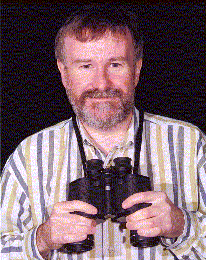
Born: 1956, Ramsgate, Kent, UK
Present position: Curator of Astronomy and Assistant
Director, Queen Victoria Museum, Launceston, Tasmania
Why I became interested in physics
From a very young age I took a keen interest in all things scientific.
However, it was looking up to the night sky that really fascinated me:
I can recall drawing star charts when I was about seven years old.
Later, taking Physics as a separate subject at high school made me thirsty
for more - I was fortunate to have a physics teacher who encouraged and
inspired me. It was obvious at a very early stage that physics went
hand in hand with my passion for astronomy - it was a delight to learn
of the many discoveries and concepts in physics that are so strongly related
to astronomical theory and observation.
What is my work like now?
I create programmes for the Launceston Planetarium - a domed theatre
onto which the starry sky is projected, simulating a nighttime environment.
The programmes cover different aspects of astronomy, and allow public,
school and university groups to learn more about the fascinating topic
of astronomy. My work at the Museum also involves the design of displays
involving different aspects of physics. I respond to many astronomical
enquiries and provide astronomical information to the media, as well as
appearing on radio and television to discuss popular astronomical topics
- in Tasmania I currently have a monthly programme on ABC Radio.
I also write numerous articles on astronomical matters for magazines and
journals, and am frequently asked to speak to community groups. I
am currently Secretary of the Australasian Planetarium Society. As
an astronomy educator, I am a member of the Education Subcommittee of the
Astronomical Society of Australia.
I lecture in undergraduate astronomy at the Launceston campus of the University of Tasmania, and contribute to research programmes involving occultations of stars by the Moon and by asteroids. Such research is helping to understand more about the Moon's orbit and to find diameters of asteroids previously unmeasured. I also conduct research into Tasmanian astronomical history.
Future prospects
I anticipate continued involvement in popularising astronomy and physics
in general - I believe that physics as a subject is of fundamental importance
to an understanding of the world around us! In recent years I have
co-authored two books and hope to continue with more. I look forward
to maintaining my links with the University of Tasmania and, when time
permits, to increased involvement in research projects at the University's
observatory.
Career path components
I studied mathematics, chemistry, computing and physics in years 11
and 12. I then attended the University of Tasmania and completed
a B.Sc. degree, majoring in physics. Following this, I spent a year
completing an honours project on photometry, which involves measuring the
light from astronomical objects at various different wavelengths.
After a few years in various part-time occupations, including assisting
with practical physics classes and assignment marking for the Physics Department,
I moved to Launceston to take up a position running the Launceston Planetarium
at the Queen Victoria Museum.